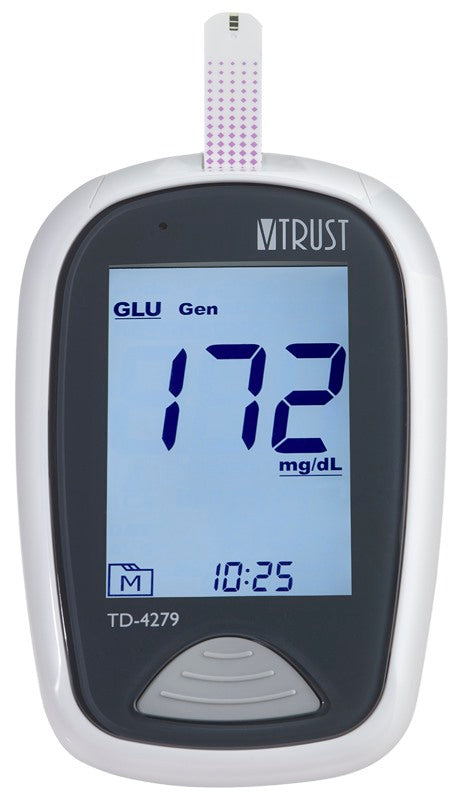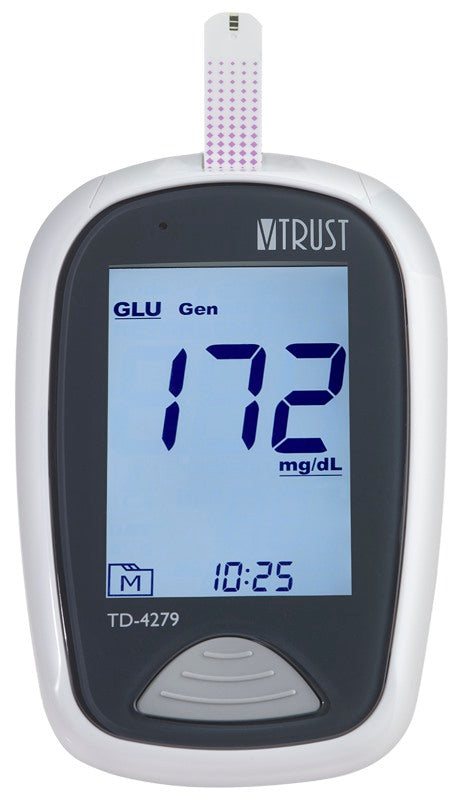VTRUST TD-4279 COMPLETE TOOL VTRUST
Sold out
€70,00
Unit price
/
Unavailable
Tax included, shipping and discounts calculated at checkout.
BIOCHEMICAL SYSTEM INTERN. | SKU:
983721022
Notify me when it's back in stock!
Write us your email, you will be notified when this product becomes available again!
VTRUST TD-4279 COMPLETE TOOL VTRUST is backordered and will ship as soon as it is back in stock.
Shipping Costs and Times
Shipping Costs and Times
- Order fulfillment within 24 hours and delivery within the following 48/72 hours.
- Shipping cost: always free for orders over €49.90, otherwise it costs €4.99.
Payments
Payments
Payment information is processed securely. We do not store credit card information or have access to your credit card information.
Returns and Refunds
Returns and Refunds
You can return and receive a refund for the item within 30 days. See full policy here.

Do you need help?
Our customer service is here to help you!
- Contact us by phone, email or WhatsApp, from Monday to Friday, from 9:00 to 20:00 .
- For common questions, such as tracking your order or checking its fulfillment status, you can count on our artificial intelligence , available 24/7 .
We are always at your side to offer you fast and effective support!
Description
Description
VTRUST TD-4279 COMPLETE TOOL VTRUST
VTRUST
VTRUST TD-4279
System for monitoring the
blood sugar and beta-ketones
Description
This system is intended for use outside the body (in vitro diagnostic use) by diabetics at home and by healthcare professionals in clinical settings as an aid in monitoring the effectiveness of diabetes and beta-ketone control.
The system is intended to be used for the quantitative measurement of glucose (sugar) in fresh fingerstick whole blood samples.
Professionals can use the system to test capillary, venous, arterial blood samples; home use is limited to testing capillary whole blood.
Specifications
How to use
Before using the tool for the first time or when changing the battery, you need to check and update the settings.
Blood sugar test
The meter offers 4 measurement modes, General, AC, PC and QC. You can switch between these modes: start with the meter turned off. Insert a test strip to turn the device on. The screen will display a drop symbol that will flash on the display and "Gen". Press the button to switch between General, AC, PC and QC modes.
Beta-ketone test
The meter only offers one “Gen” measurement mode. Start with the meter turned off. Insert a test strip to turn the device on. The screen will display the drop symbol flashing on the display and “Gen”.
Test with control solutions
Control solutions contain a known amount of glucose or beta-ketones that react with the test strips and are used to ensure that the meter and strips are working properly together.
Perform the control solution test when:
- you use the meter for the first time;
- at least once a week to regularly check the test strips and the meter;
- you start using a new bottle of test strips;
- you suspect that the strips or meter are not working properly;
- the blood glucose test results are not consistent with how the patient feels or the results are thought to be inaccurate;
- to practice the test;
- if the meter has been dropped or damaged.
Test strips, control solutions, lancets or sterile lancets may not be included in the kit (please check the contents on the product packaging). They can be purchased separately. Make sure you have all the items you need to perform a blood glucose or beta-ketone test in advance.
It is recommended to test the control solution at room temperature (20-25 °C). Before testing, make sure that the control solutions, meter and test strips are within this specified temperature range.
Insert the test strip into the meter to turn it on. Wait for the device to display the test strip and blood drop symbol.
Press the button to mark the test as a control solution test. When "QC" is displayed, the meter will store the test result in memory under "QC". If you press the button again, "QC" will disappear and the test will no longer be a control solution test. When testing with control solution, you must mark it so that the test result is not confused with the stored blood glucose test results. Otherwise, the blood glucose test results will be mixed with the control solution test results.
Shake the control solution bottle before use. Discard the first drop and apply the second drop to the tip of the bottle cap. Touch the drop to the absorbent hole of the test strip inserted into the meter. Once the confirmation window of the strip is completely filled, the device will begin counting down.
To avoid contaminating the control solution, do not apply it directly to a strip.
After counting down to 0, the control solution test result appears on the display. Compare the result to the range printed on the test strip vial: the result should be within this range. If not, please read the instructions again and repeat the control solution test.
The control solution range printed on the test strip vial is for control solution only. It does not refer to the level of glucose or beta-ketones in your blood.
Blood test
To reduce the risk of infection:
- never share a lancet or finger prick;
- always use a new sterile lancet. Lancets are for single use only;
- avoid using hand lotions, oils, dirt or residue on the lancets and lancing device.
Massaging the puncture site before drawing blood to stimulate blood flow has a significant impact on the blood glucose value obtained. Blood drawn from a site that has not been massaged has a significantly different glucose concentration than blood drawn from a massaged finger.
Before you begin, wash and dry your hands. Select the puncture site on your fingertip. Clean the puncture site with cotton soaked in 70% alcohol and allow to air dry. Massage the puncture site for about 20 seconds before pricking yourself.
Press the tip of the lancing device firmly against the underside of your fingertip. Press the button to prick your finger; a click indicates that the fingerprick is complete. Choose a different fingerprick site each time you test. Repeated pricking of the same site may cause pain and calluses. It is recommended that you discard the first drop of blood.
Insert the test strip into the meter to turn it on. Wait for the device to display the test strip and drop symbol. Select the desired measurement mode by pressing "M".
Use the adjusted lancing device to perform a finger prick. Wipe away the first drop of blood using clean cotton wool. The minimum amount of blood the device requires is 0.5 microliters (mcL) for glucose and 1 mcL for beta-ketones. Gently press the puncture site to obtain another drop of blood. Do not press the puncture site against the test strip. Be careful not to smear the blood sample.
Draw the drop of blood from the absorbent channel of the test strip. The confirmation window should be completely filled if enough sample has been applied. Do not remove your finger until you hear a beep.
If you do not apply a blood sample to the test strip within 3 minutes, the meter will automatically turn off. You must remove and reinsert the test strip to start a new test.
The confirmation window must be filled with blood before the device begins counting down. Never try to add more blood to the test strip after it has already been applied. Discard the used test strip and perform another test with a new strip. If you have trouble filling the confirmation window, please contact your healthcare provider or Customer Service for assistance.
The blood test result will be displayed after the device has counted down to zero. The results will be stored automatically.
Eject the strip by pressing the eject button located on the side. The device will automatically turn off after the strip is ejected.
Used lancets and strips are a biohazard. Please dispose of them carefully according to local regulations.
Maintenance and cleaning
To replace the batteries, make sure the instrument is turned off. Press the edge of the cover and lift it up to remove it. Remove the old batteries and replace them with two new 1.5V AAA alkaline batteries. Close the battery cover. If the batteries are inserted correctly, you will hear a "beep".
Replacing the batteries does not affect the stored test results. As with all small batteries, they should be kept away from children. If swallowed, seek medical attention immediately. Batteries may leak chemicals if unused for an extended period of time. Remove the batteries if you do not intend to use the device for an extended period of time (e.g., 3 months or more). Dispose of batteries according to local regulations.
To clean the meter externally, use a cloth moistened with water or a neutral detergent, then dry the device with a soft, dry cloth. Do not rinse with water. Do not use organic solvents to clean the instrument.
Warnings
Use the appliance only for its intended use as described in the user manual.
Do not use accessories not specified by the manufacturer.
Do not use the appliance if it is not working properly or if it is damaged.
This device is not intended to cure any symptoms or diseases. The measured data is for reference only. Always consult your doctor for interpretation of the results.
Before using the device to test your blood glucose, read all instructions carefully and practice testing. Perform all quality controls as directed.
Keep the device and blood glucose testing materials out of the reach of children. Small objects such as battery covers, batteries, test strips, lancets, and vial caps are choking hazards.
Use this device in a dry environment; in particular the presence of synthetic materials (synthetic clothing, carpets, etc.) can cause harmful electrostatic discharges which may result in incorrect results.
Do not use the instrument near sources of strong electromagnetic radiation, as these may interfere with correct operation.
Proper maintenance and periodic checks with control solutions are essential for the longevity of the device. If you are not convinced of the accuracy of the measurement, please contact Customer Service.
Avoid strong impacts or dropping the instrument.
The used meter should be treated as a contaminated object that may pose a risk of infection during measurement. The batteries of the used device should be removed and the instrument should be disposed of in accordance with current legislation.
Touch the test strip with clean, dry hands. Use the test strip immediately after removing it from the vial. Do not use test strips beyond their expiration date. This may cause inaccurate results.
Do not bend, alter, or cut a test strip in any way. Keep the test strip bottle out of the reach of children as the cap and strips may pose a choking hazard. If swallowed, seek medical attention immediately.
Conservation
Store the instrument at a temperature between -20°C and 60°C, relative humidity below 95%. Avoid direct sunlight and high humidity.
Store the strips in a cool, dry place, away from direct sunlight and heat (temperature 2-30 °C). Do not freeze. Store the test strips only in their original bottle. After removing a strip from the bottle, close the bottle cap immediately. The strips are valid until the expiration date of the unopened package.
Store the control solution tightly closed at temperatures between 2°C and 30°C. Do not freeze.
Shelf life after opening (control solution): 3 months.
Format
Contains:
- meter;
- test strips;
- control solution.
Code 3800501
This system is intended for use outside the body (in vitro diagnostic use) by diabetics at home and by healthcare professionals in clinical settings as an aid in monitoring the effectiveness of diabetes and beta-ketone control.
The system is intended to be used for the quantitative measurement of glucose (sugar) in fresh fingerstick whole blood samples.
Professionals can use the system to test capillary, venous, arterial blood samples; home use is limited to testing capillary whole blood.
Specifications
| Model | TD-4279 B |
| Dimensions and weight | 96(L) x 61(W) x 26(H)mm 67.2 g |
| Diet | Two 1.5 V AAA alkaline batteries (sufficient for approximately 1,000 measurements) |
| Display | LCD |
| Memory | 1,000 results including date and time |
| External exit | Bluetooth |
| Strip Insert Detection | Automatic |
| Sample detection | Automatic |
| Countdown | Automatic |
| Automatic shutdown | After 2 minutes of non-use |
| Temperature warning | Automatic |
| Operating conditions | 10°C to 40°C (50°F to 104°F) relative humidity (non-condensing) below 85% |
| Meter storage/Transport conditions | -20°C to 60°C (-4°F to 140°F) relative humidity below 95% |
| Storage of strips/Transport conditions | 2°C to 30°C (35.6°F to 86°F) relative humidity below 85% |
| Unit of measurement | mg/dL for glucose mmol/L for beta-ketones |
| Measuring range | From 20 to 600 mg/dL for glucose 0.1 to 8.0 mmol/L for beta-ketones |
How to use
Before using the tool for the first time or when changing the battery, you need to check and update the settings.
Blood sugar test
The meter offers 4 measurement modes, General, AC, PC and QC. You can switch between these modes: start with the meter turned off. Insert a test strip to turn the device on. The screen will display a drop symbol that will flash on the display and "Gen". Press the button to switch between General, AC, PC and QC modes.
Beta-ketone test
The meter only offers one “Gen” measurement mode. Start with the meter turned off. Insert a test strip to turn the device on. The screen will display the drop symbol flashing on the display and “Gen”.
Test with control solutions
Control solutions contain a known amount of glucose or beta-ketones that react with the test strips and are used to ensure that the meter and strips are working properly together.
Perform the control solution test when:
- you use the meter for the first time;
- at least once a week to regularly check the test strips and the meter;
- you start using a new bottle of test strips;
- you suspect that the strips or meter are not working properly;
- the blood glucose test results are not consistent with how the patient feels or the results are thought to be inaccurate;
- to practice the test;
- if the meter has been dropped or damaged.
Test strips, control solutions, lancets or sterile lancets may not be included in the kit (please check the contents on the product packaging). They can be purchased separately. Make sure you have all the items you need to perform a blood glucose or beta-ketone test in advance.
It is recommended to test the control solution at room temperature (20-25 °C). Before testing, make sure that the control solutions, meter and test strips are within this specified temperature range.
Insert the test strip into the meter to turn it on. Wait for the device to display the test strip and blood drop symbol.
Press the button to mark the test as a control solution test. When "QC" is displayed, the meter will store the test result in memory under "QC". If you press the button again, "QC" will disappear and the test will no longer be a control solution test. When testing with control solution, you must mark it so that the test result is not confused with the stored blood glucose test results. Otherwise, the blood glucose test results will be mixed with the control solution test results.
Shake the control solution bottle before use. Discard the first drop and apply the second drop to the tip of the bottle cap. Touch the drop to the absorbent hole of the test strip inserted into the meter. Once the confirmation window of the strip is completely filled, the device will begin counting down.
To avoid contaminating the control solution, do not apply it directly to a strip.
After counting down to 0, the control solution test result appears on the display. Compare the result to the range printed on the test strip vial: the result should be within this range. If not, please read the instructions again and repeat the control solution test.
The control solution range printed on the test strip vial is for control solution only. It does not refer to the level of glucose or beta-ketones in your blood.
Blood test
To reduce the risk of infection:
- never share a lancet or finger prick;
- always use a new sterile lancet. Lancets are for single use only;
- avoid using hand lotions, oils, dirt or residue on the lancets and lancing device.
Massaging the puncture site before drawing blood to stimulate blood flow has a significant impact on the blood glucose value obtained. Blood drawn from a site that has not been massaged has a significantly different glucose concentration than blood drawn from a massaged finger.
Before you begin, wash and dry your hands. Select the puncture site on your fingertip. Clean the puncture site with cotton soaked in 70% alcohol and allow to air dry. Massage the puncture site for about 20 seconds before pricking yourself.
Press the tip of the lancing device firmly against the underside of your fingertip. Press the button to prick your finger; a click indicates that the fingerprick is complete. Choose a different fingerprick site each time you test. Repeated pricking of the same site may cause pain and calluses. It is recommended that you discard the first drop of blood.
Insert the test strip into the meter to turn it on. Wait for the device to display the test strip and drop symbol. Select the desired measurement mode by pressing "M".
Use the adjusted lancing device to perform a finger prick. Wipe away the first drop of blood using clean cotton wool. The minimum amount of blood the device requires is 0.5 microliters (mcL) for glucose and 1 mcL for beta-ketones. Gently press the puncture site to obtain another drop of blood. Do not press the puncture site against the test strip. Be careful not to smear the blood sample.
Draw the drop of blood from the absorbent channel of the test strip. The confirmation window should be completely filled if enough sample has been applied. Do not remove your finger until you hear a beep.
If you do not apply a blood sample to the test strip within 3 minutes, the meter will automatically turn off. You must remove and reinsert the test strip to start a new test.
The confirmation window must be filled with blood before the device begins counting down. Never try to add more blood to the test strip after it has already been applied. Discard the used test strip and perform another test with a new strip. If you have trouble filling the confirmation window, please contact your healthcare provider or Customer Service for assistance.
The blood test result will be displayed after the device has counted down to zero. The results will be stored automatically.
Eject the strip by pressing the eject button located on the side. The device will automatically turn off after the strip is ejected.
Used lancets and strips are a biohazard. Please dispose of them carefully according to local regulations.
Maintenance and cleaning
To replace the batteries, make sure the instrument is turned off. Press the edge of the cover and lift it up to remove it. Remove the old batteries and replace them with two new 1.5V AAA alkaline batteries. Close the battery cover. If the batteries are inserted correctly, you will hear a "beep".
Replacing the batteries does not affect the stored test results. As with all small batteries, they should be kept away from children. If swallowed, seek medical attention immediately. Batteries may leak chemicals if unused for an extended period of time. Remove the batteries if you do not intend to use the device for an extended period of time (e.g., 3 months or more). Dispose of batteries according to local regulations.
To clean the meter externally, use a cloth moistened with water or a neutral detergent, then dry the device with a soft, dry cloth. Do not rinse with water. Do not use organic solvents to clean the instrument.
Warnings
Use the appliance only for its intended use as described in the user manual.
Do not use accessories not specified by the manufacturer.
Do not use the appliance if it is not working properly or if it is damaged.
This device is not intended to cure any symptoms or diseases. The measured data is for reference only. Always consult your doctor for interpretation of the results.
Before using the device to test your blood glucose, read all instructions carefully and practice testing. Perform all quality controls as directed.
Keep the device and blood glucose testing materials out of the reach of children. Small objects such as battery covers, batteries, test strips, lancets, and vial caps are choking hazards.
Use this device in a dry environment; in particular the presence of synthetic materials (synthetic clothing, carpets, etc.) can cause harmful electrostatic discharges which may result in incorrect results.
Do not use the instrument near sources of strong electromagnetic radiation, as these may interfere with correct operation.
Proper maintenance and periodic checks with control solutions are essential for the longevity of the device. If you are not convinced of the accuracy of the measurement, please contact Customer Service.
Avoid strong impacts or dropping the instrument.
The used meter should be treated as a contaminated object that may pose a risk of infection during measurement. The batteries of the used device should be removed and the instrument should be disposed of in accordance with current legislation.
Touch the test strip with clean, dry hands. Use the test strip immediately after removing it from the vial. Do not use test strips beyond their expiration date. This may cause inaccurate results.
Do not bend, alter, or cut a test strip in any way. Keep the test strip bottle out of the reach of children as the cap and strips may pose a choking hazard. If swallowed, seek medical attention immediately.
Conservation
Store the instrument at a temperature between -20°C and 60°C, relative humidity below 95%. Avoid direct sunlight and high humidity.
Store the strips in a cool, dry place, away from direct sunlight and heat (temperature 2-30 °C). Do not freeze. Store the test strips only in their original bottle. After removing a strip from the bottle, close the bottle cap immediately. The strips are valid until the expiration date of the unopened package.
Store the control solution tightly closed at temperatures between 2°C and 30°C. Do not freeze.
Shelf life after opening (control solution): 3 months.
Format
Contains:
- meter;
- test strips;
- control solution.
Code 3800501


